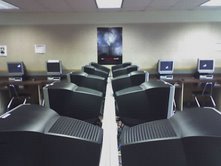 I currently work at a high school where one of my main responsibilities is to manage the school's computer labs. The school is aware that mobile technology would prove to be very helpful in education... there are some schools now with mobile laptop labs, there are wifi enabled campuses, and then there is the ability to give all the students in a classroom Palm pilots and networked them together. There are rich benefits when computing becomes further situated in the classroom... untethered computing arises new opportunities for tethering computing to a particular class context and the teacher's needs and wants...
I currently work at a high school where one of my main responsibilities is to manage the school's computer labs. The school is aware that mobile technology would prove to be very helpful in education... there are some schools now with mobile laptop labs, there are wifi enabled campuses, and then there is the ability to give all the students in a classroom Palm pilots and networked them together. There are rich benefits when computing becomes further situated in the classroom... untethered computing arises new opportunities for tethering computing to a particular class context and the teacher's needs and wants...But an interesting architectural problem arises, too: with computers more able to become part of actual classrooms, there might be less reason to have an actual "computer lab" in the high school. Does this suggest that a room for computers only exists because of the size of old computer hardware? Will networked, situated technologies mean the demise of rooms meant for computer use, particular contexts dedicated to (and with meaning attached to) computing?
On the other hand, computer labs, as a distinct space, can function like an internet cafe and spawn discussion and physical interaction in situ with computing. But in an internet cafe space anything is game and, for a school setting, this isn't always appropriate.
But if we open the school up to various new 'web 2.0' and situated technology applications, there is bound to be another problem arising, that of the educational setting's need to monitor and regulate the use of the software in order to maintain standards of safety. The issue of monitoring these new technology applications is definitely a hot topic in the realm of educational technology as ca be seen in the recent blog article in TechLearning. Educators and administrators really should take on the challenge of learning how to effectively apply these extra-institutional tools inside the institution. Schools have an opportunity to also instruct the foundations of appropriate use of these new technologies.
What if the relationship of technology and educational spaces is reorganized: rather than seeing situated technologies as mostly tools for helping users (say, the students) become more context-aware (outside of class), how about also using situated technologies to help situate an architectural context for computing itself? In other words, one solution is to make a place where situated technologies and social software can be monitoried and appropriately used at school... thus justifying the presence of a "computer lab" and the use of new technology applications and uses.
In a mobile lab setting with internet-enabled laptops or Palm pilots, teachers run the risk of students surfing away from the curriculum and there becomes an increasing need to impose restrictions and regulations on technology use. It becomes a battle between use-cultures: those in charge know one way of using technology but the students are fluent and engaged in another.
But by locating the students into the architecturally-defined, computer lab space, students can use the technology they are fluent in and teachers can learn how to administer these technologies into their curriculum in a controlled environment. Plus, the technology doesn't have to compete with what some teachers might consider learning experiences best befitting analog curriculum (like "books" and non-mediated discussions).

